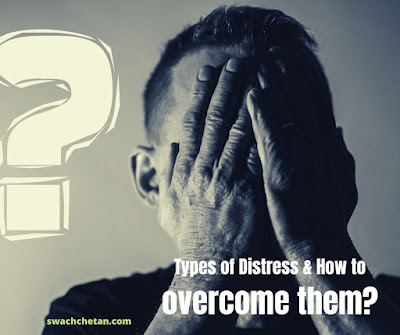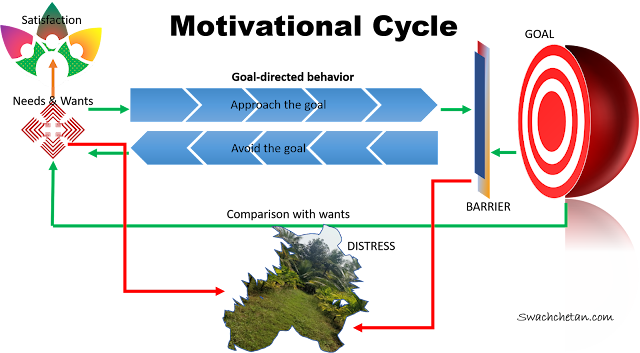Manifestation of Distress and How to Overcome Them?
Distress is an all-encompassing state where the individual is geared up
to perform at an optimum level. The objective of experiencing distress is to
ensure survival. More about the nature and characteristics of distress can be
found here: What is Distress? How are Emotions connected to Stress? and Managing everyday Distress. Distress
is also distinct from Neustress and Eustress.
Before beginning to understand the nature of stress, you can refer to the article Can we live without Goals? Here you can understand the following important concepts involved in motivation.
- Needs & Wants – Physiological | Psychological | Social
- Expectations – Overt | Covert
- Goal-directed behavior – Approach | Avoidance
- Realistic goals – Involuntary | Habitual | Voluntary
- Comparison – Self-generated | Borrowed
- Stress – Eustress, Neustress, Distress
Once you reach the goal, you stop doing what you are doing. In other words, the needs and wants are fulfilled, goal-directed behavior ceases, and satisfaction is derived.
The motivational cycle is explained
in detail in the article, Can We Live Without Goals? However,
distress comes in whenever and wherever the motivation cycle is broken or when there are barriers to reaching the goal. Distress is depicted in the diagram above.
Prolonged distress results in
Anxiety, which is the root cause of almost all disorders.
Distress in the individual is present because of the following three reasons –Pressure, Conflict, and Frustration
Depending upon the stage at which the motivational cycle is broken, each of these types of distress manifests in the individual.
Pressure is there when the need or want is forced upon the individual.
Conflict is present when there are multiple goal-directed behaviors.
Frustration ensues when there are barriers
to reaching the goal.
Pressure
Pressure can come in two ways – internal and external.
Internal pressure is when the intensity of the need or goal
increases. For example, physiological needs like hunger, thirst, sex, sleep,
defecation, etc., when deprived, lead to pressure. Psychological needs and
goals like security, safety, well-being, love, education, etc., when
denied, will lead to pressure. Social needs and goals like friends, family, work,
community, etc. when not fulfilled, lead to pressure.
External pressure is when an individual is forced with a need
or goal when they are not needed or wanted. For example, physiological needs
like hunger, thirst, sex, sleep, defecation, etc., are forced on an individual;
psychological needs and goals like security, safety, well-being, love,
education, etc., are imposed on the individual; social needs and goals like friends,
family, work, community, etc., are compelled on the individual; it leads to
pressure.
Specifically, some examples of
internal pressure are skipping a meal, falling sick, or loneliness. Some
examples of external pressure are being forced to eat when not hungry, being forced
to exercise, or being forced to develop relationships.
Conflict
There are three ways in which conflicts can manifest – conflict in approach,
conflict in avoidance, and conflict in approach avoidance.
Conflict in approach occurs when we are approaching two or more
goals but we can only choose one goal. For example, a student wants to attend a
party but has exams the next day. If s/he chooses one, s/he will have to forego
the other. People who go shopping are always in this distress. They would
want to buy everything that is available but their budget restricts them from saving money.
Conflict in
avoidance happens when we
have to avoid two or more goals but we have to choose one of them. This is a
situation that is referred to as a dilemma. Sayings like “stuck between the
devil and deep blue sea”, also refer to this. For example, a neighbor’s dog is
disturbing your sleep, but you don’t want to complain to the neighbor because
you are afraid of losing the relationship.
Conflict in approach and avoidance is present
when a goal has to be approached and avoided for contradictory reasons. Unlike
in the first two forms of conflict, here, there is a single goal. We want to
approach it for some reason/s and at the same time avoid it for some other
reason/s. For example, a homemaker wants to go to work but hates to commute
every day.
Frustration
Frustration is present when there
are barriers to reaching the goals. Sometimes obstacles may block us from
achieving our goals. The barriers could be personal or environmental.
Personal barriers are lack of knowledge,
lack of skills, attitudes, beliefs, prejudices, biases, stereotypes, etc. Environmental barriers
are time constraints, lack of technical support, financial limitations, lack of
external resources, etc.
Barriers are depicted in the
diagram above. However, barriers can arise anywhere between needs and goals
and not necessarily after the goal-directed behavior. Barriers can be there not only while approaching the goals but also while avoiding the goals. Both lead to
frustration.
In addition to the barriers,
frustration can also occur due to
- Unrealistic expectations (E.g., reaching to heaven)
- Unrealistic goals (E.g., getting a rank)
- Dissatisfaction when comparing the goal with the need or want (E.g., unhappy after negotiating to buy electronic goods)
- The discrepancy between expected and obtained satisfaction (E.g., the ambiance of the hotel is not good)
- The multiplicity of goals (E.g., wanting to win prizes in all the competitions)
- A goal without the patronage of corresponding need or want (E.g., borrowed goals)
How do you overcome distress?
Preventing distress is more beneficial than overcoming it. However,
people do not recognize stress until a disorder appears. In such a case, the
first step is to identify which type of distress is affecting the individual. The next step is to isolate the exact reason for the distressful situation and try to reduce
its impact on the individual.
Distress can be dealt with by engaging in
- Task-oriented reactions like attack, withdrawal, or compromise.
- Defense-oriented reactions like talking it out, crying it out, laughing it off.
- Ego-defense mechanisms like rationalization, projection, and repression.
Withstand Pressure
Not yielding to the pressure, whether it is
internal or external, and learning to resist pressure can help us in reducing distress. Most people turn to addiction because they are unable to withstand
pressure. Internal pressure can be minimized by ensuring that we are not deprived
of the need. External pressure can be reduced by learning to say ‘No’ or
increasing the necessity of the goal.
Resolve Conflict
We can reduce the conflict by choosing one of the alternatives and learning to forego the other alternatives. Lose something to gain something – this saying applies very well,
here. We must learn to evaluate and select the one alternative that has more
advantages and fewer disadvantages. Learning decision-making skills also helps
in resolving conflicts.
Conquer Frustration
Frustration can be conquered by circumventing the barriers, modifying expectations and goals, learning satisfaction, having specific goals corresponding to the needs, and eliminating borrowed goals. One major indication that we are frustrated is to get angry. If we can identify the cause of frustration whenever we get angry, we can conquer frustration. More specific details are available in the article on anger management.
Thus, distress is not as simple as
it is made out to be nor uncontrollable. If we know how to manage the
pressures we go through, identify the conflicting situations we encounter, and
tolerate frustration, we can reduce distress in life. This will help us in
generating positive emotions in all our interactions.














Please do not include any spam links in the comment box.